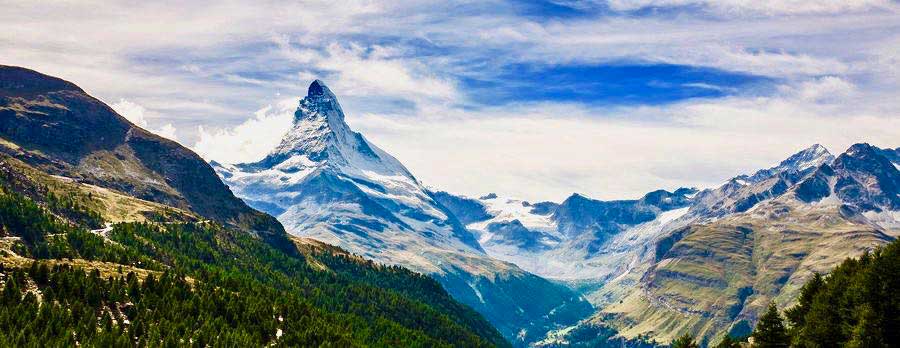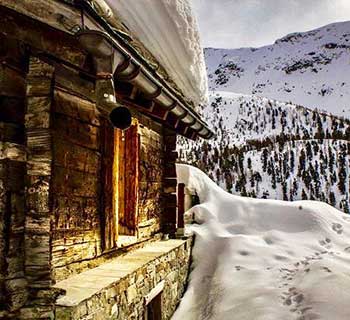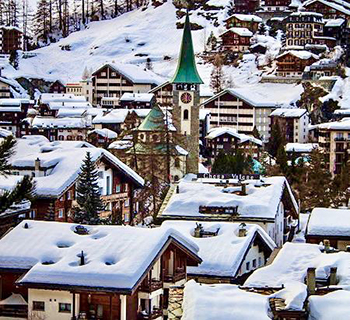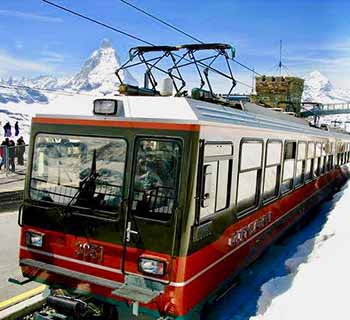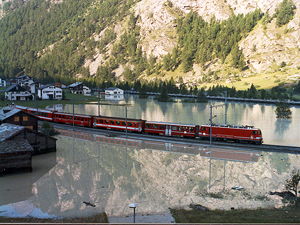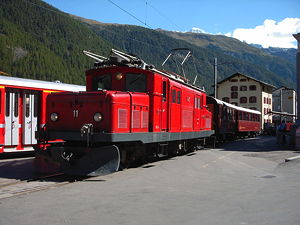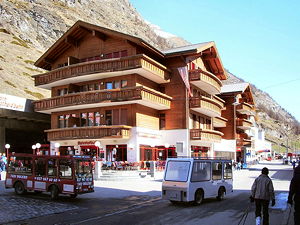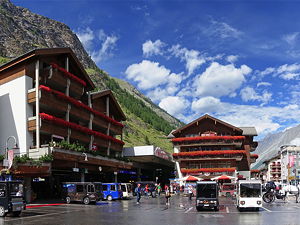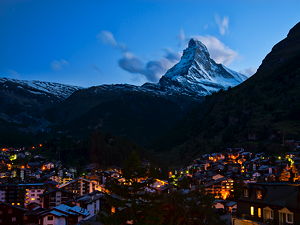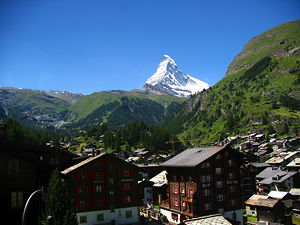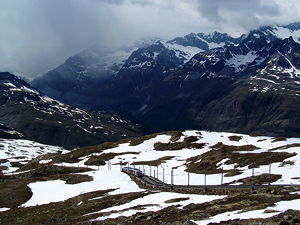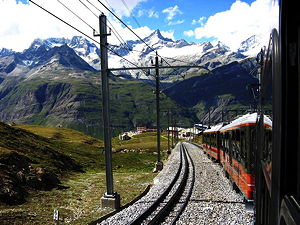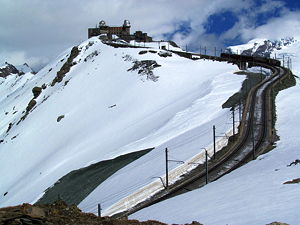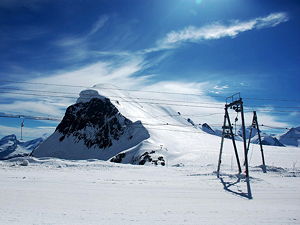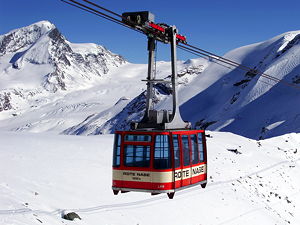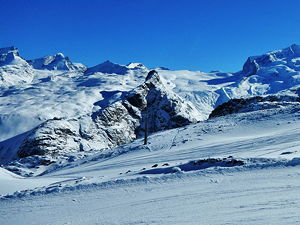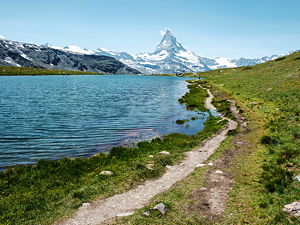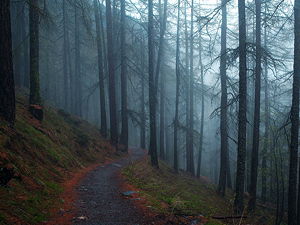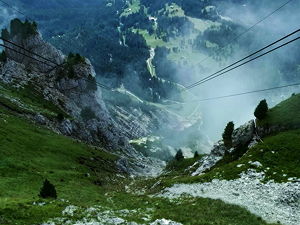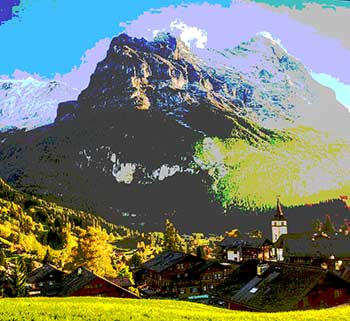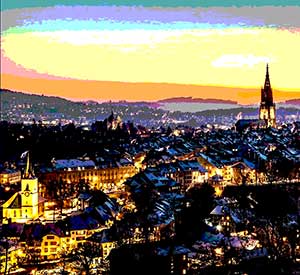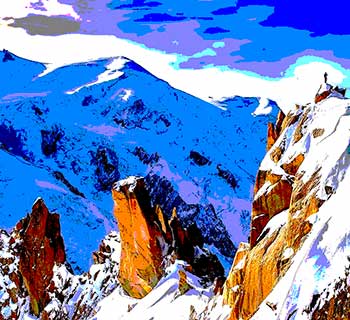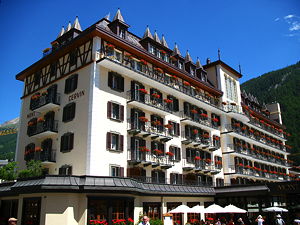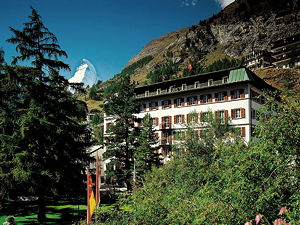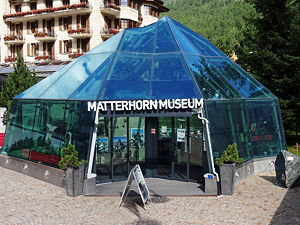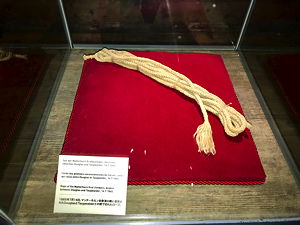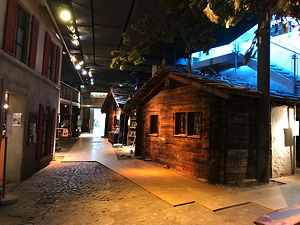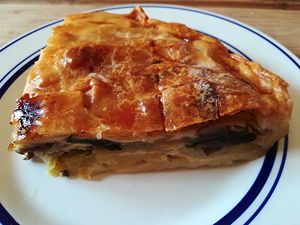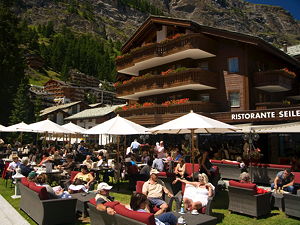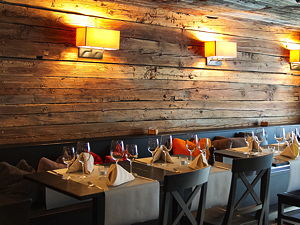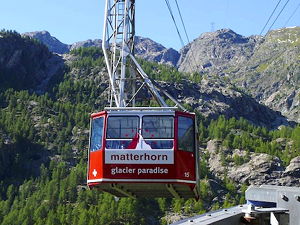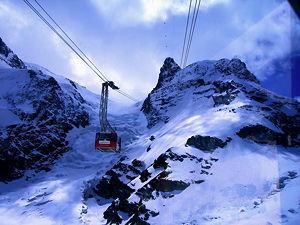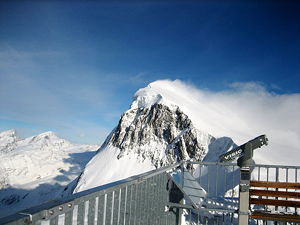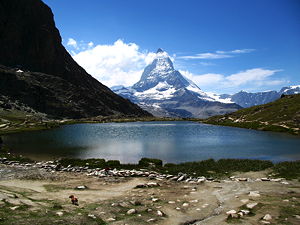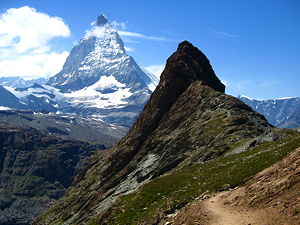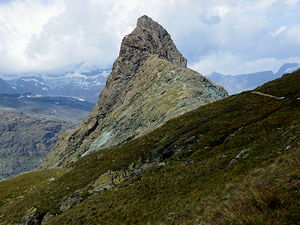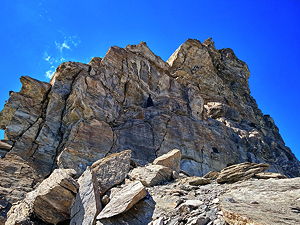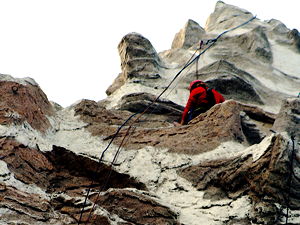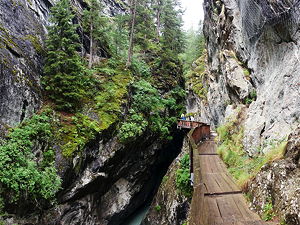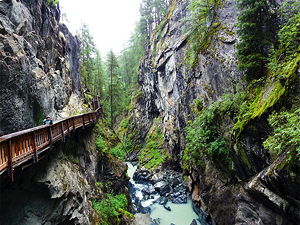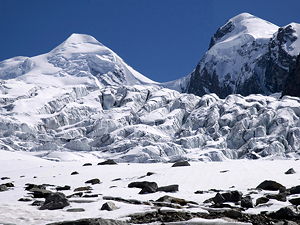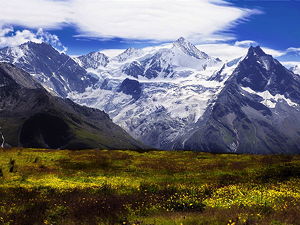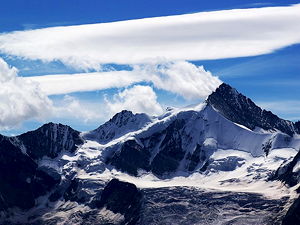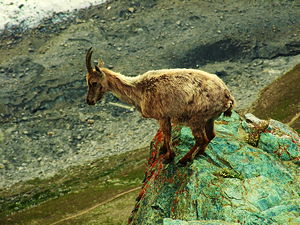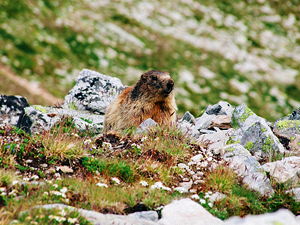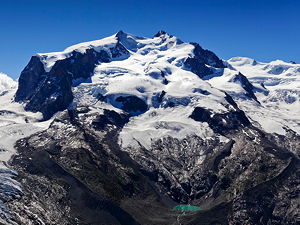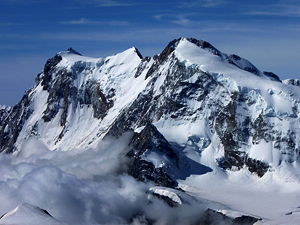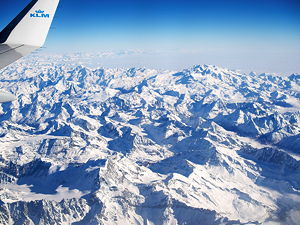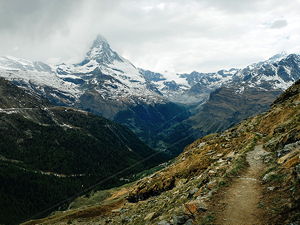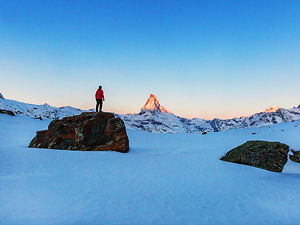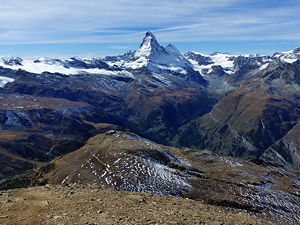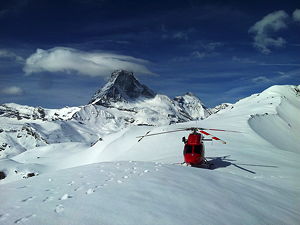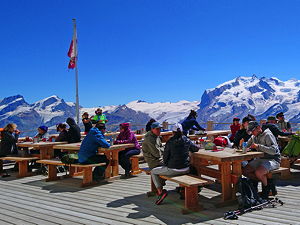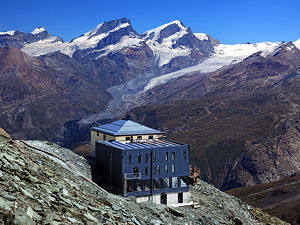Things to do in Zermatt, Switzerland
The car-free town of Zermatt, located in the Valais Canton at an altitude of 1600 metres, holds a magnetic attraction for those who love the mountains.
The 4,478 metre Matterhorn—one of the world's most famous and beautiful mountains—towers over central Zermatt, with a further twenty-eight 4,000 metre peaks (including the Monte Rose and Mont Blanc) visible from the Gornergrat mountain railway station (3135 metres, 40 minutes from the town centre).
In addition, Zermatt has over 400 kilometres of walking trails and 245 kilometres of pistes for skiing and snowboarding. They are found predominantly on the east side of the valley, accessible via a network of mountain railways, cablecars and gondolas. The Zermatt valley's unspolit west side, by contrast, offers tranquility and the possibility of seeing rare alpine fauna such as the marmot, chamoix and ibex.
Visitors also flock to Zermatt for culture, great shopping, luxurious five-star hotels, world-class spas, welcoming mountain restaurants, high class traditional and international cuisine, lively apres-ski and a wonderful atmosphere. It is a perfect place to relax and enjoy the great outdoors.
Peak ski season in Zermatt is between late November and early May, though the height of the Klein Matterhorn cablecar station (3883 metres) means that year-round skiing is available on a number of glaciers. There are lots of things to do in summer, where peak season is between mid-June (when the snow has melted on the higher walking trails) and early October.
Want to discover more about Zermatt? Check out our Zermatt events & festivals, map, restaurants and photo gallery pages.
1. BVZ Zermatt-Bahn
The car-free Zermatt is best accessed by the BVZ railway: the relaxing journey offers stunning mountain views.
The railway is a narrow gauge that runs from Brig (at 724 metres), to Visp (817 metres), Täsch (1450 metres) and on to Zermatt (1616 metres). The whole 44 km journey takes about 80 minutes, and has a maximum gradient of 12.5%.
The locomotives and carriages are painted bright red and are, as with all public transport in Switzerland, relentlessly efficient. But the real joy in the journey lies in taking in the mountains on the way.
We recommend sitting on the left hand side of the carriage facing the direction of travel (on the way up), so that you can catch views of the Monte Rosa range.
In addition to the mountains, the train passes a number of attractions including pretty chalets, villages, gardens and even the unexpected 9-hole Matterhorn Golf Course.
where? From Brig and Zermatt railway stations. MAP
when? First trains leave Brig and Zermatt at about 5.30 am, with last trains leaving at about 10.30 pm. Check the train timetable.
£$€¥ A 2nd class return costs CHF76, with 1st class costing CHF134 (Aug 2024). You can save money on Swiss railways by purchasing a half-fare card, which also works on most mountain railways and cablecars (CHF 120 for one month).
2. Getting to know Zermatt
Get to know Zermatt by following our walking tour.
Your first impression of Zermatt will be its bustling railway concourse, packed with electric vehicles ready to whisk hotel guests and their bags away (though those staying in Zermatt's two five-star hotels, the Mont Cervin and the Zermatterhoff, will be treated to a short horse and carriage ride instead).
If you want to get to know Zermatt, turn right as you leave the station and walk up Zermatt's busy Bahnofstrasse. There are lots of things to see: the street is packed with restaurants, cafes, bars, discos, and clothes, outdoor equipment and jewellery stores.
Shopping ...
Zermatt must be one of the only places on earth where shops selling Armani suits, Patek Phillipe watches and ice axes are found within metres of each other.
We particularly recommend the Lorenz Bach outlet store in the arcade opposite the Mont Cervin Hotel, where you will find a range of top designers at bargain basement prices.
Zermatt's church
Further up the high street you will find Zermatt's pretty church and the Matterhorn Museum. Take a few minutes to pay your respects to the climbers who have been killed in the mountains surrounding Zermatt, many of whom are buried in the small graveyard between the church and the river.
Carry on for five or ten minutes past the Church, taking in the pretty chalets, until you reach the lower Glacier paradise cable car station. Then return to town via the river, the Matter Vispa. The circular walk will take about an hour.
when? Zermatt is busy all year round, with skiers and snowboarders in the winter and hillwalkers, mountaineers and sightseers in the summer. Advanced booking is recommended if you are planning to attend Zermatt's events and festivals.
3. The Gornergrat Railway
The railway trip to Gornergrat (at 2883 metres) is Zermatt's most popular attraction, taking you into the heart of the Swiss Alps.
The journey of 9.33 kms (and 1200 metres of ascent!) takes about 40 minutes on the way up and slightly longer on the way down. It also takes in a number of other interesting features, including forests, meadows, gorges, tarns, bridges and tunnels.
The views from Gornergrat
When you arrive, you will (on a clear day) be able to enjoy fantastic views of twenty-nine 4,000 metre peaks, including the Matterhorn itself, the Breithorn (4164m), the Monte Rosa (Europe's second-highest peak, at 4633m), Mont Blanc (Europe's highest peak at 4810 metres, found in Chamonix) and the Gornergletsher glacier (the second longest glacier in the Alps).
Walk down?
Many visitors choose to walk down some of the mountain, before re-joining the train at the Rotenboden or Riffelberg stops. Be sure to keep an eye out for ibex, chamoix and marmots.
Gornergrat has another claim to fame: in August 2013, over 500 horn blowers gathered together here to set the world record for the greatest number of horns played simultaneously!
where? Trains leave from a small station opposite Zermatt's main train station. MAP
when? Trains run throughout the year, normally every 24 minutes. First trains leave at around 7 am, and final trains from Gornergrat leave at about 7 pm. Sunrise packages are available for early birds between June and early September—but be warned, in June the train leaves Zermatt at 4.30am! Gornergrat is a popular place to visit, so expect crowds.
£$€¥ Prices starting from: Adults: CHF 132 return; Children (6-16): CHF66 return; Children under 6: free; Prices highly depend on the season, so please make sure to check out the website for further information (Aug 2024)
4. Skiing in Zermatt
Zermatt is the world's most complete ski resort.
Visitors flock for a number of reasons: a top elevation of 3,820 metres, 245 kilometres of marked pistes, challenging off-piste terrain, 73 ski-lifts and mountain railways, and the 13-kilometre run down to central Zermatt, with 2,200 metres of descent.
Zermatt's ski areas
Zermatt has three principal skiing areas, all on the east side of the valley. The first descends from the 3,103 metre Rothorn. The second from the spur which includes the 3,400 metre Stockhorn and Gornergrat. The last from the 3,820 metre Klein Matterhorn cablecar station.
The height of the Klein Matterhorn, the world's highest cable car station, means that excellent snow conditions prevail until early May and that skiing is possible all year round.
Runs for all abilities
Only 23% of Zermatt's runs are suitable for beginners (blue runs), with 44% suitable for intermediate skiers (red runs) and 33% for those with advanced ability (black runs).
Advanced skiers will also enjoy Zermatt's National, Gant, Aroleid and Triftji mogul fields.
Boarding and apres-ski
Boarders are well catered for, with two snowboard parks and two man-made half-pipes (one at Blauherd, the other between Trockner Steg and Furgg).
Other activities include eating hearty fare at Zermatt's 38 mountain restaurants, apres-ski, two natural and one artificial ice-rinks, and 30 kilometres of cleared winter footpaths.
Skiing and boarding are the things to do in Zermatt in winter.
when? Zermatt's three main skiing areas are open from November to May. In addition, Zermatt's Snowpark (on the Theodul glacier and accessed by the Furggsattel chairlift) offers 21 kilometres of skiing, accessed by eight lifts, all year round; this makes Zermatt the destination of choice for many national ski teams.
£$€¥ Adult ski passes for cost CHF92 for a day, CHF197 for three days and CHF341 for a week (Aug 2024).
5. Zermatt Walking: the Höhbalmenstafel and Trift
The trek to Höhbalmenstafel (2665 metres), which offers stunning views of the Trift Gorge, Matterhorn and Monte Rosa, is one of Zermatt's top tourist attractions.
The circular walk can be completed in 5-6 hours and involves 1000 metres of ascent. For those after a more challenging excursion, why not attempt the Wisshorn (2911 metres, 1300 metres ascent, 7 hours), the Platthorn (3343 metres, 1700 metres ascent, 8-10 hours) or the Mettelhorn (3403 metres, 1800 metres ascent, 9-11 hours).
The Höhbalmenstafel
From Zermatt's railway station, head towards the Church at the top of Zermatt's main street, and take a right turn shortly afterwards. Walk up the hill and out of the town. You will quickly find signposts towards Trift (2337 metres), a two-hour walk from the town centre involving 700 metres of ascent. The route is strenuous, but the views of the Trift gorge (pictured) are fabulous; you pass through the pretty Edelweiss hamlet (where you can stop for a drink) at the halfway point.
At Trift, we recommend resting at the Hotel for a pint of home-brewed iced tea and a just-from-the-oven slice of fruit pie. Then head to the left, up to the Höhbalmenstafel. After about an hour from Trift, the Matterhorn will come into view. This is a great lunch and photo spot.
There are three ways down: the steep way (straight back down to Zermatt, taking just under two hours); the way you came up (about 2 hrs 30 mins); and the long way (which takes you further up the valley and past an interesting hydro-electric installation, taking about 4 hrs).
These walks are amongst the best things to do in Zermatt in summer.
Alternative routes from Trift
There are three alternative routes from Trift. Each starts with an hour-long ascent in a north-easterly direction. At about 2750 metres, you reach a signposted fork in the track. For the Wisshorn, regarded as one of Zermatt's best viewpoints, turn right and continue for 40-50 minutes to the summit.
For the Platthorn and Mettelhorn continue for another two hours until you reach a distinctive ridge. From here, the Platthorn's summit is only 20 minutes away. For the Mettelhorn, you need to cross a short section of glacier, before reaching a steep zig-zagging path to the summit. MAP
when? The best time to walk in Zermatt is late May to September. Those without experience should not walk on glaciers. For all others, bring your crampons and check the glacier conditions at the Trift hotel.
£$€¥ Free. A large glass of iced tea at the Trift hotel costs CHF6.
